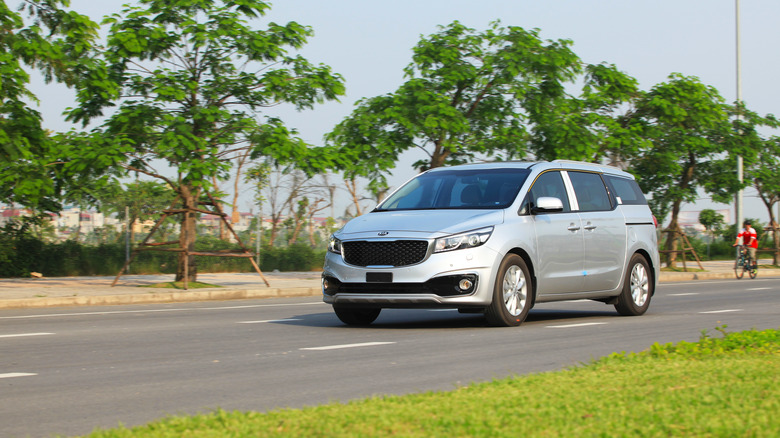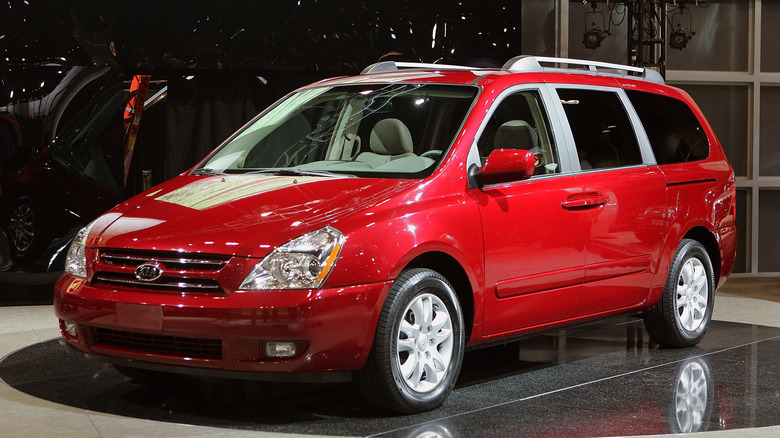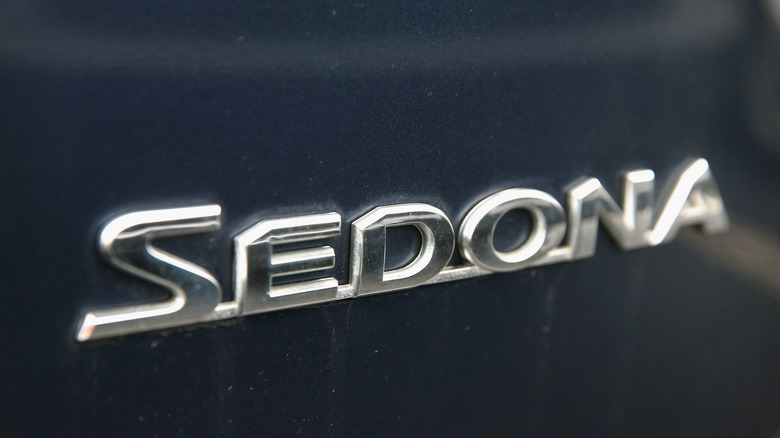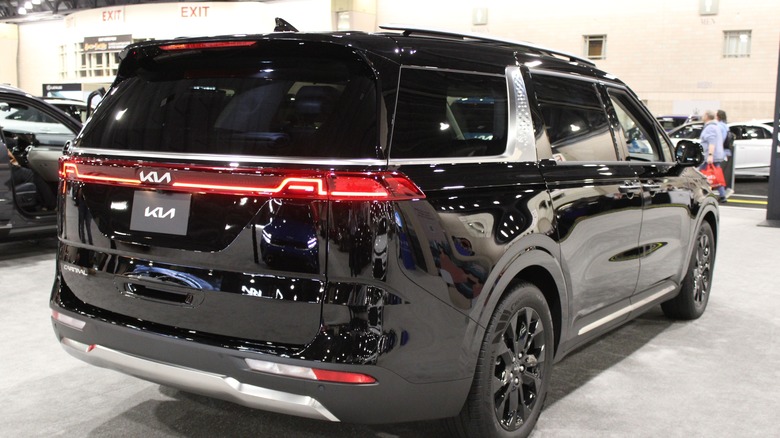No, The Kia Carnival Hasn't Been Discontinued (But Its Old Nameplate 'Sedona' Has)
South Korea's Kia, across its range, offers a lot of family-oriented vehicles. The Picanto, for instance, may be a small model, but with Apple CarPlay and wireless smart device charging, it's oriented for keeping those little passengers occupied mid-journey (to the extent that's possible). What about those who have bigger broods, though? The Kia Carnival offers something distinctly larger for those transporting the whole family en masse.
As is the case with so many vehicles, nameplates vary around the world. The vehicle U.S. drivers know as the Dodge Dart, for instance, is more familiar in some other regions as the Fiat Viaggio. In just the same way, you may know the Carnival as the Sedona instead. It was a big and substantial model that had some heavyweight rivals throughout its lifespan, but absolutely made its presence known in the minivan arena. Actually, Kia was voted one of the most reliable minivan brands in our 2022 survey.
Unfortunately, Kia ultimately discontinued the Sedona. The Carnival, meanwhile, lived on in a distinctly different guise. Let's take a look at the history of the Sedona, how it was affected by shifting tastes in the industry, and how it attained a new lease on life as it adopted the Carnival nameplate that was already established in other regions.
The debut of the Kia Sedona
The Kia Sedona first launched outside of the United States in 1998. It was a model that wanted to tick all the boxes that minivan drivers would seek to prioritize: cargo space, comfort, and considerable power. The idea, after all, isn't typically to scream around racetracks (not that minivan racing isn't an absolute sight to behold), but to be able to transport a family or other large group and all their supplies.
The 1998 Sedona, which would be named the Kia Carnival in some other regions, came in six different varieties. The V6 gasoline model, with its 2,497 cc engine, offered 173 horsepower, a top speed of approximately 114 mph, and 162 pound-feet of torque. There were also diesel versions of the model, including a 2,902 cc automatic weighing in at 133 horsepower and 228 pound-feet of torque. In the late 1990s, there were some rather formidable minivans that the Carnival/Sedona had to keep pace with, and it certainly did that. The often-underappreciated Toyota Previa, for instance, had a 2.4-liter engine that could output 132 horsepower and 151 pound-feet of torque. Performance wise, the Sedona could top this vehicle by a significant margin, as the Previa could reach only 106 mph.
On its arrival in the United States for the 2002 model year, the Sedona was equipped with a V6 with a 3.5-liter capacity. Though it was more than competitive, it ran afoul of the time's shifting attitudes toward the minivan more broadly.
The lifespan of the Sedona in the United States
After it arrived, the Sedona would go through several generations' worth of redesigns, tweaks, and improvements. The second generation Sedona, which was released in the U.S. for 2005, had its output boosted to 224 horsepower, driven by a 3.8-liter V6. The 2015 model year marked the debut of the third generation model, which was designed by Peter Schreyer.
The concept was minimizing the profile of the vehicle to a certain extent, using a more elegant beltline, without its look detracting from its capabilities. With room for seven (as well as the freedom to adjust the seating configuration) and 248 pound-feet of torque from its 3.3-liter gas V6, the third generation Sedona was an effort to maintain the strengths of the minivan while reducing the emphasis on the hefty form factor that such vehicles typically have.
The fourth generation Sedona was the last to use the name. This was perhaps the most intriguing generation of all, and it was particularly significant that Kia referred to it as a Grand Utility Vehicle when it was first shown in June 2020. The moniker further suggests an adaptation of SUV qualities, as reflected in the reduction of certain elements of its form factor (such as the roof and overhangs being given a more angular, sporty appeal). Kia had a very good reason for leaning toward a design like this: The SUV was flourishing at the time.
How the rise of the SUV seemingly doomed the Sedona and its minivan rivals alike
Minivans were designed to adhere to the principles of practicality. There are sleek, aerodynamic, and beautiful vehicles designed for pace, and then there are the likes of the formidable-yet-far-from-beautiful Ford Winstar. These roomy wonders, sadly, would largely find their positions usurped by the powerful SUVs that every major brand began to build.
What do SUVs offer that minivans don't? Generally speaking, they offer a very nice middle ground for those who would deem a minivan too large for their needs, while also being better able to tackle some potentially unfriendly terrain. Individual drivers' needs, of course, will widely differ, but there will always be general trends in the auto market. In the late 1990s and into the 2000s and 2010s, those trends seemed to suggest that there was a distinct decline in the United States' enthusiasm for minivans. The Sedona was but one victim of this attitude shift, and Kia had been taking steps to respond to it.
The Sedona minivan, with the 2021-2022 model year transition, would be reborn as the Carnival in the United States. With that, the Sedona's odyssey of around two decades came to an end. U.S. drivers, as such, would be forgiven for thinking that the vehicle family as a whole had been discontinued.
Kia is set to launch a new Carnival in 2025
Kia's Sedona/Carnival survived in the U.S. against stiff competition in the minivan market. No slouch in the performance department, it also benefited from one of the most important virtues a vehicle can possess at face value: a relatively low price. The '21 Sedona had an MSRP of $30,400, while the rebranded '22 Carnival stood at $32,100. These base prices highlight one big selling point the Sedona has always had. In fact, in October 2001, Car And Driver went so far as to deem the then-$19,590 base Sedona as "fine dining at fast-food prices."
The state of fast food prices in 2024 is a different concern, but the point still stands: A capable and rather attractive minivan at a reasonable price is a vehicle worthy of retaining, and it's good that the Carnival family survived the end of the Sedona nameplate. Your friends here at SlashGear noted in a review of the '23 Kia Carnival, "the days of the minivan being a bland bus are long gone. This 2023 Kia Carnival SX Prestige, for example, brings a lavish second row with recliners for its $47,395 (plus $1,295 destination) sticker price."
With the 2025 Kia Carnival going turbo hybrid, the vehicle family has been further developed, with Kia boasting that the Carnival MPV Hybrid will hit the U.S. market with "best-in-class" torque (at 271 pound-feet) and sophisticated feature options including a 360-degree Surround View Monitor.




